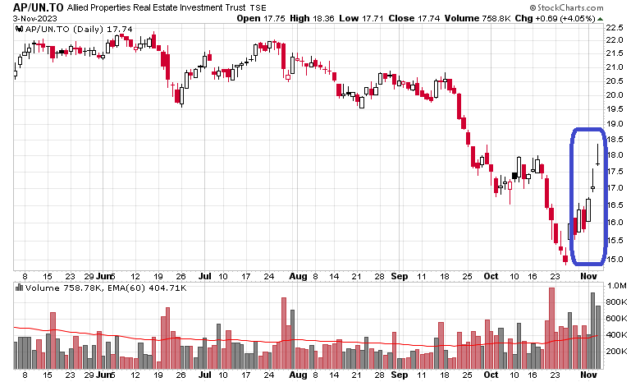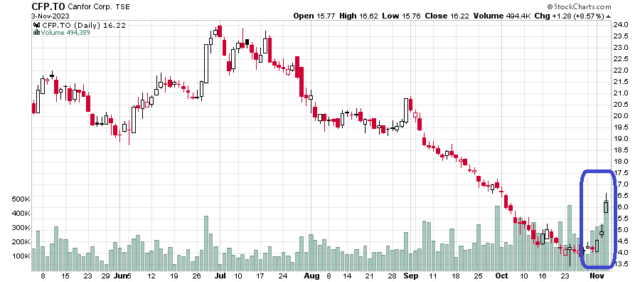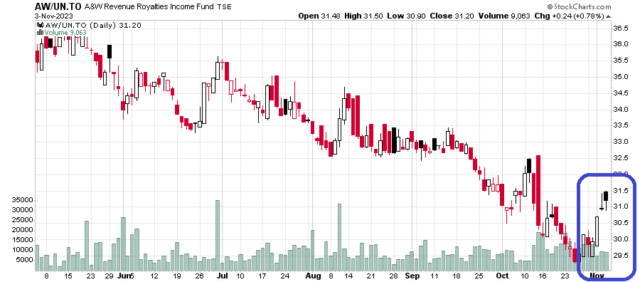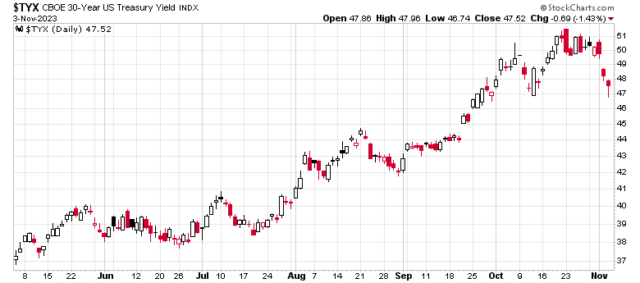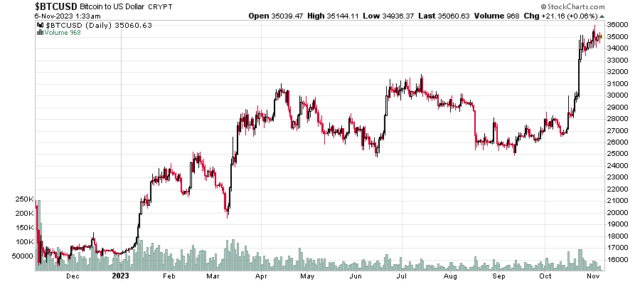I’ve been looking at the Canadian Convertible Debentures that are scheduled to mature between now and December 31, 2023. Some observations:
Medexus (TSX: MDP.DB, October 16, 2023 maturity) – This will mature on Monday for a cash payment at 125 of par (a very unique offering). To be honest, this one surprised me in that I was expecting some sort of distressed debt situation, but the company managed to scrape enough pennies together through a newly minted credit facility in early March 2023, some decent financial results posted on June 2023 and finally a secondary equity offering that concluded a week ago – striking while the equity was hot. Management navigated this whirlpool quite well, and at 24 employees, each person’s individual effort really counts for these types of companies. Before they get delisted I’ll post their chart, again noting that payout at maturity is 125 of par:
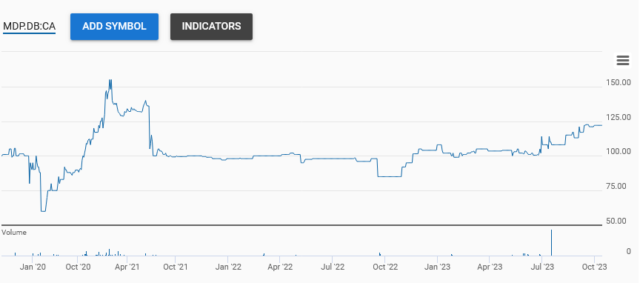
The rest are December 31, 2023 maturities:
Aecon Group (TSX: ARE.DB.C) – $184 million due. The company has a $600 million credit facility, of which $188 million was drawn out on June 30, 2023. Conversion is at $24/share and the stock is at $10.59/share, so very likely a cash maturity. Even a mediocre execution in the next six months will not result in these debentures getting in trouble and hence the 99% of par trading price at present. This engineering firm has been kind of lost since the Canadian government shot down its acquisition by a Chinese national firm many years back, but they continue to meander along despite being in a market where there is going to be plenty of demand going forward. The problem is that engineering firms need to retain talented individuals that need enough motivation to stay in such firms, which facilitates both the precise costing and execution of projects. It is one thing to get contract wins, it is another thing entirely to discover that your costing is so out of whack that in order to execute on such projects that you’re going to be losing money. A great example of this is the construction of the North Vancouver sewage plant which appears to be a case of a company being completely out of its depth.
Firm Capital (TSX: FC.DB.G) – $22.5 million due. Conversion is $15.25 with the stock price at $9.80. Firm Capital has many issues of convertible debentures outstanding at various maturities, trading roughly 4-5% above the government yield curve. The company proactively sent out a financial release on September 19, 2023 which attempted to reassure the market that despite their mortgage portfolio outstanding shrinking in size, that they are solvent. In particular, a $180 million credit facility remains untapped and combined with cash, this is comfortably facilitating a cash maturity of this particular issue. However, it is pretty clear that FC is going to have to make some tough choices – they traditionally have funded their loans through convertible debentures at really cheap coupons – the latest ones (FC.DB.K, FC.DB.L) were a combined $90 million out for 5 years with a 5% coupon with a conversion price well out of the money ($17.75 and $17.00/share!) – the last offering was done in January 2022 and this was PERFECT timing by management – there is no chance at all of them doing this again in the current rate environment.
Northwest Healthcare Properties REIT (TSX: NWH.DB.G) – $125 million due. Conversion is $13.35/unit with a current unit price of $4.57. The quick summary here is that the trust is in serious financial trouble. I remember this REIT being one of these “dividend starlings” that the usual retail crowd hyped up on financial twitter and the like, and unless if management is skillful, this one is potentially heading down to a zero. With specific regard to the ability to redeem this debenture, the trust is hitting a financial limit with its term facility (on June 30, 2023 there is $165 million available to be drawn). The minutiae in their last quarterly filing includes distressed paragraphs like this:
On August 2, 2023, the REIT executed an interim non-revolving tranche under its revolving credit facility to increase availability by $50.0 million. The tranche matures in October 2023 and can be extended until January 2024 under certain circumstances. The facility is secured by certain assets in the REIT’s Americas portfolio and it bears interest ranging from 10.6% to 13.8%.
… 10.6% to 13.8%! Ouch!
Subsequent to June 30, 2023, the REIT extended the maturity date of its revolving unsecured credit facility with an outstanding balance of $125.0 million credit facility by one year to November 2024, The facility bears interest ranging from 8.73% to 10.01% (previously 8.23% to 9.51%).
Banks are ratcheting the screws on the trust…
They released a September 22, 2023 financial update trying to assure the market that with some “non-core” asset sales coupled with some other measures they are “fortifying” the balance sheet, but there is indeed a danger that this convertible debenture will be partly redeemed in units by the company. While writing this post, I notice the “fantastic” SEDAR Plus is down for maintenance so I could not confirm directly that the indenture allows for this, but a previous MD&A does allude to this being an option for the company. The two other outstanding convertible debenture issues (maturing roughly in 4 years) are trading at a YTM of 12.5% so refinancing is not going to be in the cards for this REIT. My guess is that they squeeze out a cash maturity but good luck in the future!
